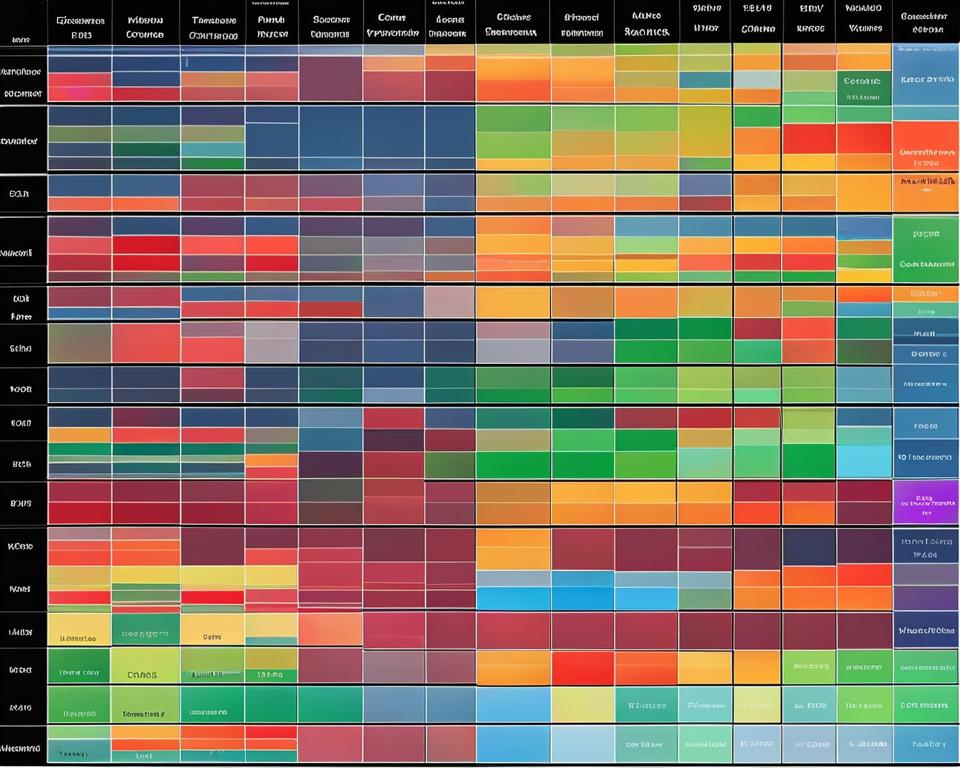When it comes to income investing, American investors are often faced with a pivotal decision: should they opt for the ease and diversification of dividend-focused ETFs or the direct ownership and potential higher rewards of individual stock portfolios? Both avenues are popular strategies for cultivating passive income investments and have their own set of benefits and drawbacks. ETFs amalgamate a variety of dividend-paying stocks under one umbrella, offering a convenient and diversified path for those looking to expand their investment horizons. In contrast, individual stocks necessitate a granular approach, empowering investors with more control over their selections and tailored income strategies. The choice between these two can define the financial landscape of one’s future, influencing risk, returns, and overall stability. Understanding the nuances between them is a fundamental step for any investor seeking to augment their income through the stock market.
Key Takeaways
- Dividend-focused ETFs provide a diversified portfolio with exposure to a variety of dividend-paying companies.
- Individual stock portfolios offer more control and personalization for investors looking for tailored income strategies.
- Passive income investments can be conveniently managed through ETFs, while individual stocks require active engagement.
- Diversification in ETFs may help mitigate risk, whereas individual stocks can offer higher potential returns.
- Both investment strategies are viable for income investing, but each investor’s goals and preferences will determine the best fit for their portfolio.
The Allure of Dividends in Income Investing
For countless investors, the quest for passive income investments often lands on the steady allure of dividends. These periodic distributions from a company’s profits are not just a mere reflection of financial health but also a cornerstone for those prioritizing income investing. The ability to harness a stream of income through dividends—if chosen wisely—can establish a robust financial backbone, particularly important for retirees and those seeking additional income streams. At the core of this investment strategy is understanding the dividend yield, a metric that signifies the percentage of a company’s market price paid out to shareholders in dividends, offering a snapshot of the potential income relative to the stock price.
Dividends can be seen as a beacon of profitability and corporate assurance, making dividend-paying stocks and funds highly sought after. These payments are often made on a quarterly, semi-annual, or annual basis, aligning with individual financial planning cycles. However, the approach to investing in these income-yielding assets varies greatly with the choice between two primary vehicles: individual dividend-paying stocks or dividend-focused funds. Each path to dividend investing carries unique attributes, catering to different investor needs and preferences.
As the dividends debate unfolds, investors are urged to evaluate their personal financial objectives, market knowledge, and time horizon to make the most of these attractive passive income opportunities. With a balanced perspective of the inherent risks and rewards, the resulting strategy could lead to an optimized income-generating portfolio crafted to one’s specific financial landscape.
| Investment Type | Pros | Cons | Ideal for Investor |
|---|---|---|---|
| Individual Dividend Stocks | Potential for high dividend yield and personal control over selections. | Requires active management and carries higher risk with concentrated positions. | Those with investment acumen and a preference for tailored portfolio. |
| Dividend-Focused Funds | Professional management and diversification across various sectors. | Possibility of lower yields due to a broad spread of investments. | Investors favoring a hands-off approach and portfolio diversification. |
Distinguishing between these investment types is essential for capitalizing on dividend opportunities, thus reinforcing dividends as a pillar of passive income for income-focused portfolios. Regardless of the chosen route, a thorough dive into the dividends sphere can lead to an empowered stance in sculpting an investment path that resonates with one’s aspirations for steady financial growth.
Understanding Dividend-Focused ETFs
Within the investment landscape, dividend-focused ETFs represent a streamlined approach to income generation. They are investment vehicles that amalgamate a diverse range of dividend-paying ETFs, with the intent of striking a balance between sustained income and capital appreciation. These instruments cater to investors aiming for steady returns as well as those seeking growth in their capital, thereby addressing different investment aspirations with flexibility and resilience. As we delve deeper into these ETFs, we identify concrete benefits that make them appealing choices for investors of various profiles.
Definition and Purpose of Dividend ETFs
A dividend-focused ETF is designed to track indices composed predominantly of companies that regularly distribute a portion of their earnings to shareholders. Diligently curated to deliver both security and performance, these funds stand out due to their inherent design to cater to those seeking high-yield ETFs. By holding such ETFs, investors gain the opportunity to benefit from dividends across different market sectors, which is particulary advantageous for those not inclined to micromanage their investments.
Pros of Choosing Dividend-Paying ETFs
Opting for dividend-paying ETFs can be a masterstroke for the astute investor, largely due to the portfolio diversification these baskets of securities offer. By distributing investments across a plethora of dividend-generating companies, ETFs inherently reduce the potential financial setback an investor might encounter with the underperformance of a single stock. Moreover, for those seeking convenience without compromising on the quality of their investments, dividend-focused ETFs provide the ease of professional management and the ability to participate in market gains all through a singular transaction.
- Immediate portfolio diversification across various sectors
- Reduction in risk associated with single stock investments
- Access to a range of high-yield ETFs and strong dividend yield perspectives
- Convenience of professional management, enhancing passive income streams
Dividend-focused ETFs unite the desires of income-seeking investors with the agility needed to thrive amidst the dynamic melodies of the market. Whether the goal is to build a retirement nest egg or to create an avenue for passive income, these funds often emerge as the prudential choice synonymous with the promise of stability and growth. Keep in mind, the ultimate portfolio structure should align with personal investment objectives, time horizon, and appetite for risk.
The Appeal of Individual Dividend Growth Stocks
Investors inclined towards maximizing their income potential often find themselves drawn to the allure of individual dividend growth stocks. Unlike dividend-focused ETFs, which spread holdings across various sectors, opting for individual stocks allows one to venture into the realm where dividend yields and equity appreciation potentially converge to elevate an investor’s portfolio.
What exactly frames the attraction towards these singular investment opportunities? It is the pursuit of not just passive income but also the chance for capital gains as companies grow and increase their payouts. It’s this dual benefit that can lead to more substantial personal wealth over the long term for dedicated investors.
What Sets Individual Dividend Stocks Apart
Heart of the matter is simple yet impactful – individual dividend stocks offer a gateway to potentially higher yields. These are not merely tickers on a digital board, but slices of ownership in real companies with solid track records of profit sharing. Such entities often signal financial maturity and a robust business model, reflected in their ability to incrementally boost dividends over time, which funds, given their diversified nature, typically can’t rival.
Direct Control Over Stock Selection
The freedom to exercise direct control over stock selection is another compelling reason propelling savvy investors towards individual dividend stocks. Fostering a granular degree of control, informed investors can craft portfolios shaped by in-depth research and strategic foresights. This portfolio diversification, albeit within one’s controlled confines, does not just happen; it is actively built upon insights, predictions, and a definitive evaluation of risks versus rewards over a chosen investment horizon.
- Greater potential for above-average dividend yield
- Opportunities for significant value appreciation
- Focused investment in sectors with growth potential
- Tailored portfolio construction aligned with individual goals
- Possibility for personalized risk management
| Characteristic | Individual Dividend Stocks | Dividend ETFs |
|---|---|---|
| Potential Yield | Higher, depending on stock selection | Steady, diversified yields |
| Value Appreciation | Varies company to company, higher possibility with sound choices | Linked to market index or fund strategy, moderate growth |
| Investor Control | Complete, with active engagement | Limited, dependent on fund management |
| Risk Management | Controlled through careful stock selection and diversification | Inherent through fund’s diversification across many holdings |
| Investment Approach | Focused, research-intensive, and strategic | Passive, broad-market exposure, and convenience |
Choosing individual dividend growth stocks is an art form in itself, balancing the excitement of handpicking potential winners against the sober responsibility of continual diligence. This is the realm where investor intuition, bolstered by rigorous assessment, meets the potential for financial advancement. And for those well-versed in the nuances of market movements and company portfolios, it may lead to that coveted blend of income and enrichment which is the hallmark of a successful investment strategy.
Professional Management vs. Self-Directed Portfolios
The decision to engage in professional management or to maintain a self-directed portfolio is a pivotal juncture in the journey towards building passive income investments. Professional management in investment funds comes with a suite of services that alleviate the pressures of continual market analysis, stock selection, and strategic planning. Investors benefit from a dedicated team whose sole focus is the continual growth and resilience of the fund’s assets. The significant advantage here lies in the diversification of risk and the aggregation of expertise that underpins the decision-making processes within these managed funds.
Conversely, self-directed portfolios echo the sentiments of those investors who hold a deep understanding of market dynamics and possess the prowess to maneuver through the intricacies of portfolio management. Here, the investor enjoys the freedom of crafting an investment strategy that is fine-tuned to personal financial goals and risk appetites. This path, while offering the potential for higher returns through carefully selected stocks, demands a significant investment of time and resources for research and continuous oversight.
As such, the choice between professional management and self-directed investment is not to be taken lightly. One must weigh the value of time against the willingness to assume direct control over their financial futures. Passive income seekers who prefer a more hands-off approach may find solace in the expertise professional managers bring to the table. Those favoring the autonomy afforded by self-directed portfolios should be prepared to navigate the exhilarating, yet often turbulent, waters of stock market investment.
| Consideration | Professional Management | Self-Directed Portfolios |
|---|---|---|
| Expertise Required | Relies on professional expertise | Requires investor’s own expertise |
| Time Commitment | Minimal (managed by professionals) | High (requires regular monitoring) |
| Diversification | Typically offers built-in diversification | Depends on investor’s choices |
| Risk Consideration | Risk spread across multiple assets | Potential for higher risk with concentrated picks |
| Control | Limited (decisions made by fund managers) | Complete (investor makes all decisions) |
| Potential for Passive Income | Steady, based on fund performance | Varies, can be maximized by investor strategy |
In summary, the divergence between professional management and self-directed portfolios encapsulates the quintessential debate of convenience versus control within passive income investment strategies. The direction one chooses should harmonize with their investment philosophy, available time, and confidence in navigating financial markets. Financial independence through stock investment has diverse paths, each with its merits and challenges, but the quest for passive income remains a common goal that unites all investing endeavors.
Risk and Reward: Diversification Considerations
Investors often grapple with the concepts of risk management and reward maximization when building their investment portfolios. The key element balancing these two factors is diversification. In the world of income investing, particularly when it comes to dividends, the selection between dividend-focused ETFs and individual stocks presents distinct challenges and opportunities for managing risk and maximizing potential returns.
Impact of Diversification on Risk Management
Diversification serves as the keystone in the arch of investment risk management. Dividend-focused ETFs provide a degree of diversification that is difficult to replicate with individual stocks. Each ETF holds a multitude of companies, spanning various industries, thereby reducing the overall volatility of the investment. This holistic approach can be crucial in mitigating the risk inherent in a portfolio that could otherwise be exposed to sector-specific or company-specific downturns.
Portfolio diversification through ETFs dilutes the risk and reward impact of any one company. Consequently, the effect of a single stock plummeting due to company-specific news is lessened on the overall portfolio. However, it’s not only about cushioning the fall. Diversification also encompasses the risk of not participating in significant gains from an individual stock’s stellar performance. Hence, investment decisions should be thoughtful of the diversification level most aligning with one’s appetite for risk.
Understanding Portfolio Concentration
Portfolio concentration is another essential axis of consideration. It raises the stakes on both sides of the risk and reward spectrum. Investors with a concentrated portfolio may experience high returns when a chosen stock performs vigorously. The flipside is also true: A few underperforming stocks can disproportionately drag down the portfolio’s value, a risk known as idiosyncratic risk.
Here lies the art of balancing a diversified yet focus-aligned portfolio. A well-crafted blend allows investors to partake in the rewards of concentrated high-performers while mitigating potential losses. It’s a strategy that requires fine calibration of risk tolerance against the desire for lucrative returns. The optimal balance is unique to each investor and pivots central to effective investment decisions.
| Strategy | Diversification Level | Risk Profile | Typical Reward Potential |
|---|---|---|---|
| Dividend-Focused ETFs | High | Lower overall volatility | Steady, potentially lower versus concentrated picks |
| Individual Dividend Stocks | Varies | Higher idiosyncratic risk | Potential for significant gains from select stocks |
Comparing Dividend Yield and Potential Income
The determination of where to park one’s investment funds for the most attractive returns is a crucial choice for those invested in high-yield investing. Dividend yield and potential income are two fundamental concepts that often guide this decision-making process. Whether one leans towards the variety provided by dividend-focused ETFs or the targeted approach of individual dividend stocks, understanding the nuances between these options becomes central to forming a coherent investment strategy.
Analyzing Yield Variations Between Dividend ETFs and Individual Stocks
The landscape of dividend investing reveals a variety of yield opportunities for different types of investors. Dividend-focused ETFs, such as Vanguard High Dividend Yield Index Fund (VHDYX), typically offer a moderate yield reflective of a wide range of companies that prioritize returning income to shareholders. These funds aim for income consistency and risk management through broad diversification.
Meanwhile, portfolios composed of carefully chosen individual dividend stocks might demonstrate higher average yields, which could translate to greater potential income for investors willing to engage in extensive research and active portfolio management. The potential for high-yield investing in this avenue is notably significant for seasoned investors with an eye for spotting robust dividend payers.

Income Consistency: ETFs vs. Stocks
In the realm of income consistency, dividend-focused ETFs generally offer a reliable and predictable income stream, with diversification across numerous companies cushioning the overall portfolio against the dividend policy changes of any single constituent. This is a key advantage for those who value stability in their passive income strategies.
Conversely, individual dividend stocks can yield higher, albeit more variable income streams. The income from these stocks is inherently subject to the performance and dividend policy decisions of each company, necessitating a higher degree of vigilance and responsive management by the investor.
| Investment Type | Average Dividend Yield | Income Consistency | Research Intensity |
|---|---|---|---|
| Dividend ETFs | Moderate yield typical | High level of consistency across portfolio | Low (predominantly passive approach) |
| Individual Stocks | High yield potential | Variable, dependent on company performance | High (requires active engagement) |
As investors continue their analysis of dividend yield and potential income, they must weigh the relative merits of stability against the lure of higher returns, each pathway providing a different balance of risk and reward. Ultimately, both dividend-focused ETFs and individual dividend stocks hold their place in the diversified income-seeking investor’s toolkit.
Tax Implications for Dividend Investors
Dividends are a favored form of return on investment for many, but they are not free from the grasp of taxation. Understanding the tax implications of dividend investments is vital for investors seeking to optimize their after-tax returns. Income from dividends in taxable accounts can significantly affect one’s annual tax liabilities, especially when it comes to the nuanced differences between qualified dividends and ordinary dividends.
Qualified dividends, as defined by the Internal Revenue Service (IRS), enjoy a lower tax rate, mirroring that of capital gains taxation. This preferential rate applies to dividends paid by U.S. companies or qualifying foreign companies, provided the investor has held the underlying stock for a specific period. However, not all dividends meet the criteria for this beneficial tax treatment.
In contrast, ordinary dividends are taxed at one’s regular income tax rate, which could be considerably higher than the rate for qualified dividends. It’s this potential for a lower tax burden that makes the distinction between qualified and non-qualified dividends a key consideration.
When it comes to dividend-focused ETFs versus individual stocks, there’s another layer of tax considerations to be aware of. Unlike owning individual stocks, where investors may have better control over realizing capital gains, dividend mutual funds are legally obligated to distribute their capital gains to shareholders annually. This can result in unexpected tax liabilities regardless of whether the investor sells any fund shares.
| Investment Type | Tax Rate on Qualified Dividends | Capital Gains Distribution Required |
|---|---|---|
| Individual Stocks | 0%, 15%, or 20% based on income | No |
| Dividend ETFs/Mutual Funds | 0%, 15%, or 20% based on income | Yes |
As such, those investing through dividend ETFs may experience a different tax outcome from those who handpick individual dividend stocks. The tax efficiency of one’s investment portfolio can play a crucial role in the net gains retained by the investor. Hence, seeking advice from a tax professional could prove beneficial in developing a strategy that aligns with overall investment goals while considering the important aspect of tax implications on investment returns.
Investment Expenses: Fees and Commissions
Scrutinizing the costs associated with their investment choices is a prudent practice for every investor. This is especially true in the realm of dividends, where the overall profitability can be significantly affected by investment expenses such as expense ratios and trading costs. Whether considering dividend-focused ETFs or individual stocks, understanding and managing these costs is essential to enhance net returns and achieve your financial goals.
Expense Ratios of Dividend ETFs
Expense ratios represent the annual fees that cover fund management and operational costs, which all investors must factor in when choosing investment vehicles like dividend-focused ETFs. They vary broadly, exemplified by the Vanguard High Dividend Yield (VHDYX) which boasts a lower expense ratio, advocating for cost-effective growth. In stark contrast, actively managed funds such as the American Funds Investment Company of America (AIVSX) demonstrate expense ratios at higher industry averages. These management fees, albeit seemingly small percentages, can compound over time and have a palpable impact on the return on investment.
Trading Costs Associated with Individual Stocks
The allure of individual stocks might seem free from annual maintenance costs observed in funds, but they carry their own type of expenses in the form of trading commissions. Each purchase or sale of a stock could incur a commission fee, which, when accumulated through frequent trading, can nibble away at the investment’s worth. Investors engaged in active trading through a brokerage advisory account may also be subject to advisory fees, typically calculated as a percentage of assets under management. Consider, for instance, the potential costs associated with a high-turnover approach that could drastically diminish the effective yield of an income-generating portfolio.
| Investment Type | Expense Ratio | Trading Costs | Impact on Returns |
|---|---|---|---|
| Dividend-Focused ETFs | Lower (VHDYX at 0.15%) to Higher (AIVSX at 0.57%) industry average | Typically none (bundled in the expense ratio) | Annual fees compounded, reducing net returns |
| Individual Stocks | N/A | Variable (Based on commission rates and trading frequency) | Can be minimized with long-term holding strategies |
Investors are encouraged to carefully consider these often-overlooked costs to preserve their hard-earned returns. By doing so, one can more accurately project the return on investment and make better-informed decisions aligning with financial ambitions, whether they include the purchase of dividend-focused ETFs or the selection of individual stocks.
Accessing Dividend Aristocrats and High-Yield Opportunities
Securing a spot in the realm of income investing can be transformative for investors aiming to craft portfolios that thrive on stability and growth. Tapping into the elite group of Dividend Aristocrats and exploring high-yield opportunities offers a pathway to bolster financial security through precipitated, consistent income streams. These investment strategies not only epitomize sound financial wisdom but also pave the way for dynamic portfolio diversification.
The Role of Dividend Aristocrats in ETFs and Stocks
Dividend Aristocrats, companies with an illustrious history of consistently increasing dividends for a minimum of 25 years, are the venerated champions of income investing. Their reputation for stability and reliable growth makes them a coveted asset for both dividend-focused ETFs and investors in individual stocks. ETFs that prioritize these admirable enterprises can offer investors a blend of venerable reliability and indomitable spirit, ensuring that their garden of gains is tended to by seasoned hands.

Individual stock investors, on the other hand, who personally curate portions of their portfolios to include these stalwarts, can directly engage with companies whose dividends have flourished through economic ebb and flow. Incorporating Dividend Aristocrats into their portfolios allows investors to tap directly into the veins of corporate giants long-celebrated for their financial alchemy, transforming robust profits into golden threads of dividend yield.
Seeking High-Yield Investments
Whereas Dividend Aristocrats provide a secure bastion for steady, increasing dividends, the pursuit for high-yield investments can lead investors along varied paths. Dividend ETFs tend to render a composite yield reflective of diversified holdings. Though this yield might traditionally be moderate, it gleams with the sheen of stability and is often praised for securing peace of mind.
Steering towards individual dividend stocks, investors may discover the labyrinths of the market are lined with high-yield opportunities. This strategy beckons the well-informed who meticulously screen and select stocks proffering dividend yields as lustrous crowns. Yet, this quest for the ultimate yield requires a discerning eye and the resolve to shoulder the toils of research and potential volatility.
Ultimately, whether one leans on the pillars of tried-and-true aristocrats or scouts the horizon for high-yield opportunities, the art of income investing demands a stage on which both the conservative and the courageous can perform. Balancing portfolio diversification with individual picks, investors can waltz to a symphony uniquely tailored to their own financial rhythms and aspirations.
Market Volatility’s Influence on Dividend Investments
Investors who prioritize dividend investments often consider the stability and predictable income these assets can offer, especially within a well-balanced portfolio. However, an undeniable factor that plays a critical role in both the yield and value of these investments is market volatility. The tumultuous nature of the stock market can transform the landscape of perceived secure dividend-paying assets.
Market volatility refers to the frequency and magnitude with which market prices fluctuate. High volatility typically indicates a turbulent market with rapid price changes, while low volatility corresponds to a more stable market environment. Such volatility can impact investment performance, influencing the perceived attractiveness and actual payoff of both dividend-focused ETFs and individual dividend stocks.
For dividend investors, a key strategy in confronting market volatility lies in diversification, which is readily provided by ETFs that pool a variety of dividend-paying assets. This collation does not only spread risk but can also buffer the investor’s portfolio against sharp declines in any single stock. The intrinsic resilience of dividend-focused ETFs to market swings makes them a favored choice for those who value consistency over high-stakes gameplay.
| Investment Type | Impact of Market Volatility | Investor’s Comfort with Market Swings | Average Dividend Yield | Portfolio Diversification |
|---|---|---|---|---|
| Dividend ETFs | Lower impact due to diversification | Preferred by risk-averse investors | Moderate (Due to diversified assets) | High (Across various sectors) |
| Individual Stocks | Higher sensitivity to single-stock performance | Preferable for risk-tolerant investors | Varies (Potential for higher yield) | Low (Unless manually diversified) |
The other side of the coin presents individual dividend stocks, where greater risk associated with market volatility could potentially lead to higher rewards. Seasoned investors comfortable with analyzing market trends may find individual stocks appealing as they provide an opportunity to harvest increased dividends during market highs. This active approach, however, mandates vigilance to the market’s ebb and flow as investment performance can be significantly disrupted by sharp price movements.
Ultimately, the decision between choosing dividend ETFs and individual stocks is not solely reliant on the potential income but also the individual’s risk tolerance and their ability to weather the effects of market volatility. Careful consideration of this aspect of investing is paramount as it significantly shapes the investment journey and its outcomes.
The Impact of Interest Rates on Dividend Income Strategies
The investment landscape is constantly shaped by the ebb and flow of interest rates, influencing the decision-making process of investors focused on dividend yields and income strategies. As rates shift, so does the attractiveness of dividend-paying assets, requiring investors to reassess their portfolios to account for rate sensitivity. Both dividend-paying ETFs and individual dividend stocks react differently to these economic tides, thus demanding a prudent evaluation from those aiming to maximize their investment income.
Interest Rates and the Attractiveness of Dividend Yields
Rising interest rates often lead investors to reevaluate the lure of dividends. As fixed-income assets become more appealing, the fixed payouts from dividend-paying ETFs could lose some of their shine, potentially resulting in a decrease in their market value. Investors vested in individual dividend stocks might also feel the impact, albeit to a varying degree based on the particular assets and their idiosyncrasies related to interest rate movements.
Comparing Rate Sensitivity Between ETFs and Stocks
The rate sensitivity of an investment can greatly affect its performance. Dividend ETFs with a focus on income-earning assets may exhibit higher sensitivity to interest rate fluctuations, attributable to their sector concentration and higher yield commitments. Contrastingly, individual dividend stocks, especially those with prospects of growth, may prove less vulnerable to rate hikes, proposing a more balanced appeal between income and growth potential for investors.
| Investment | Yield Sensitivity to Interest Rate | Investor Consideration | Income vs. Growth |
|---|---|---|---|
| Dividend-Paying ETFs | Higher | Diversified assets with fixed income | Prioritizes income over growth |
| Individual Dividend Stocks | Variable | Direct ownership, company-specific | Opportunities for both income and growth |
The intricacies of navigating the impact of interest rates on dividend income call for a fine-tuned approach to portfolio management. Whether you lean towards the aggregated convenience of ETFs or the selective precision of individual stocks, acknowledging how each is affected by the financial climate is key to cultivating a resilient income strategy. As market conditions evolve, an informed perspective on these dynamics ensures investors can adapt effectively, seeking to sustain and grow their investment income in all interest rate scenarios.
The Role of Sector Concentration in a Dividend Portfolio
For investors looking to optimize their dividend portfolio, navigating the balance between sector concentration and diversified income streams is key to managing investment risk. Dividend exchange-traded funds (ETFs) often concentrate on sectors like utilities and consumer staples, historically known for regular and reliable payouts. While this can provide a stable income source, it also exposes the portfolio to the volatility of specific sectors. Conversely, choosing individual stocks allows for a tailored approach to sector involvement, potentially leading to a more robust portfolio that can withstand economic fluctuations. This strategic customization facilitates diversification, a vital component for mitigating risk and stabilizing returns.

Sector concentration within an investment portfolio represents the level of exposure to the risks associated with specific industry sectors. Historically, certain sectors have demonstrated a propensity for consistency in dividend payouts, attracting those seeking reliable income streams. However, overexposure to any single sector can result in heightened sensitivity to industry-specific economic events or regulatory changes, possibly affecting the expected dividends.
To illustrate the implications of sector concentration, consider the following table outlining the characteristics of portfolios with varying degrees of sector-specific investments:
| Investment Strategy | Sector Concentration | Risks and Rewards | Income Stream Diversification |
|---|---|---|---|
| High Sector Concentration (Utilities) | High | Potential for stable dividends but increased vulnerability to sector downturns | Low |
| Balanced Sector Spread (Dividend ETFs) | Moderate | Reduced sector-specific risk, leading to more stable but potentially lower yields | High |
| Custom Sector Selection (Individual Stocks) | Customizable | Ability to manage risk actively; potential for high reward with well-chosen stocks | Varies based on investor’s strategy |
In pursuit of diversified income streams, investors may gravitate towards an individually curated set of dividend stocks. This allows for a proactive approach in selecting sectors that align with personal investment strategies and diversification goals. Deploying a multi-sector strategy moderates the risks and enables participation in the upside of different industries.
Ultimately, the extent of sector concentration in a dividend portfolio should be dictated by an investor’s risk tolerance, financial goals, and market outlook. By weighing the potential for higher yields against the associated sector-specific risks, one can make informed decisions that balance the desire for income with the need for risk management.
Passive Income Investments: Resilience and Growth Potential
The pursuit of passive income investments is often synonymous with financial security and growth potential. Investors who focus on dividend payers have the opportunity to draw upon the resilience and maturity of well-established companies, which can be indicative of a firm’s longevity and overall financial health. Furthermore, these income streams present unique opportunities for reinvesting and nurturing compounded returns that may lead to wealth accumulation over time.
Longevity and Financial Stability of Dividend Payers
Dividend-paying entities are often celebrated as bastions of financial stability. These companies showcase a consistent ability to generate profits and share those gains with investors, broadcasting a signal of enduring corporate health. Such financial robustness often translates into an investment that can withstand economic fluctuations and continue delivering value to shareholders in various market conditions.
Growth Potential and Reinvestment of Earnings
While dividends are typically associated with the steady preservation of capital, they also hold the key to unlocking growth potential within an investment portfolio. Whether through dividend-focused ETFs or choices in individual stocks, the practice of reinvesting dividend earnings back into the market supports the time-honored principle of compounding. As such, dividend reinvestment can catalyze the future compounding returns, fostering the bedrock for long-term wealth creation and a solidified personal finance journey.
Conclusion
In the realm of income investing, the journey towards a resilient source of passive income can be navigated through two predominant paths: dividend-focused ETFs and individual stock portfolios. Each path offers its unique set of attributes, tailored to meet the diverse financial aspirations and risk appetites of investors. Dividend-focused ETFs stand out with their significant diversification and professional management, providing a safeguarded route to passive income that is less prone to market fluctuations. Meanwhile, individual stock portfolios offer investors an avenue for potentially higher yields, achieved through direct control and selection tailored to specific income requirements.
When we consider factors such as management style, tax considerations, and investment expenses, it becomes clear that these are not just choices between investment vehicles but are steps toward crafting a financial strategy closely aligned with personal goals. For investors who champion hands-on involvement and strategic oversight in their investment pursuits, individual stock portfolios may resonate more profoundly with their approach to crafting wealth.
On the other hand, those seeking to preserve time and minimize risk will find a ready ally in dividend-focused ETFs. These funds strategically position investors to benefit from the cumulative strength of a broad spectrum of stocks, providing a stable backdrop against the ripples of market volatility. Thus, one’s decision between the ease of ETFs and the engagement required by individual stocks should be shaped by a thoughtful integration of personal risk tolerance, financial objectives, and the level of active involvement desired in the pursuit of passive income. In traversing the terrain of income investing, the key lies in selecting the path that not only aligns with one’s financial portfolio but also one’s life portfolio.
FAQ
What are the key differences between dividend-focused ETFs and individual stock portfolios?
Dividend-focused ETFs provide diversified exposure to a basket of dividend-paying companies, managed by professionals, and offer a hands-off investment approach ideal for passive income investments. Individual stock portfolios, meanwhile, require active management with direct ownership of stocks, allowing for tailored stock selection and potentially higher yields but also carry higher risk and demand in-depth market knowledge.
What makes dividends attractive in income investing?
Dividends are attractive in income investing as they represent a steady stream of income, reinforcing the appeal of investments as a stable source of passive income. They serve as a sign of a company’s financial health and can offer an inflation hedge, making dividends a cornerstone for many income-focused strategies.
What is the purpose of dividend-focused ETFs?
The purpose of dividend-focused ETFs is to provide investors with broad exposure to a curated selection of dividend-paying stocks in a single investment vehicle. This offers the advantages of portfolio diversification, professional management, and more consistent income streams, which are key for those interested in income investing and generating passive income.
What are the pros of choosing dividend-paying ETFs?
Pros of choosing dividend-paying ETFs include immediate diversification which reduces investment risk, the convenience of professional management, cost-efficiency through lower expense ratios compared to active fund management, and the regular income from dividends which is attractive for passive income seekers.
How do individual dividend growth stocks stand apart?
Individual dividend growth stocks stand apart by offering the potential for higher dividend yields and significant value appreciation over time. They allow investors to build a portfolio aligned with specific investment goals and risk tolerance, provided they are willing to undertake considerable research and continuous portfolio monitoring.
How does direct control over stock selection benefit investors?
Direct control over stock selection enables investors to handpick companies based on their performance metrics, sector allocation, and dividend history. It empowers them to make precise investment decisions which can result in a portfolio tailored to individual financial objectives and risk preferences.
How does professional management differ from self-directed portfolios?
Professional management, typically offered by dividend ETFs, handles the investment strategy and ongoing management which reduces the time burden on investors and is conducive to passive income strategies. Self-directed portfolios, on the other hand, rely on the individual to make all investment decisions, offering a higher degree of control but requiring more time and expertise.
What is the impact of diversification on risk management?
Diversification impacts risk management by spreading investments across various assets or sectors, thereby reducing the overall risk. For dividend income strategies, diversification through ETFs can protect against the negative impact of any single stock’s underperformance, enhancing income stability.
What should an investor understand about portfolio concentration?
Investors should understand that a concentrated portfolio may offer higher potential returns as a result of focused investments but also poses higher risks if those select investments perform poorly. This contrasts with the broader diversification in ETFs that tends to balance risk and reward more evenly.
How do yield variations between dividend ETFs and individual stocks compare?
Yield variations can be considerable between dividend ETFs and individual stocks. While ETFs offer yields that reflect a broader market segment, individual stocks can be selected to potentially provide higher average yields, though this involves more research and carries higher risk.
How do ETFs and stocks compare in terms of income consistency?
ETFs generally offer more income consistency due to the diversified nature of their holdings which can smooth out the volatility in dividend payments. Individual stocks, while potentially offering higher income, can result in more fluctuating income streams due to dependency on the specific companies’ dividend policies.
What are the tax implications for dividend investors?
Tax implications for dividend investors include the favorable tax treatment of qualified dividends, which are taxed at long-term capital gains rates. Taxes must also be considered on capital gains distributions from funds, whereas individual stocks offer more control over when capital gains are realized, potentially optimizing tax impact.
What should investors know about expense ratios of dividend ETFs?
Investors should understand that expense ratios represent the annual fees charged by ETFs to cover management and operational costs, which can impact their net returns. Low expense ratios, as seen in some high-yield ETFs, are attractive for their lower costs, while higher expense ratios can detract from the overall gains.
What trading costs are associated with individual stocks?
Trading costs associated with individual stocks include broker commission fees for each transaction, which can add up in actively traded portfolios. Furthermore, active traders using professional services may incur additional advisory fees, which should be factored into the overall investment strategy.
How do dividend aristocrats play a role in ETFs and stock portfolios?
Dividend Aristocrats are sought after in both ETFs and individual stock portfolios for their proven record of consistently raising dividends. ETFs may specifically target Dividend Aristocrats, offering a combined exposure, while individual investors can selectively invest in these companies to tap into their reliable growth in dividends.
What should be considered when seeking high-yield investments?
When seeking high-yield investments, investors should consider the balance between the desire for high yields and the inherent risks. Higher yields can often be accompanied by higher risks, such as those from companies in distressed industries. Careful analysis is needed to identify sustainable high-yield opportunities.
How does market volatility influence dividend investment decisions?
Market volatility influences dividend investment decisions as it affects the stability of stock prices and dividend payments. A well-diversified dividend ETF can provide a buffer against volatility, whereas individual stocks are subject to greater price swings which can affect the consistency of dividend income.
What is the relationship between interest rates and the attractiveness of dividend yields?
Interest rates have a direct relationship with the attractiveness of dividend yields. As interest rates rise, new fixed-income opportunities emerge that may offer higher returns, making dividends less attractive in comparison. This can negatively impact the value of dividend stocks and ETFs, especially those that are more yield-sensitive.
How does rate sensitivity differ between ETFs and stocks?
Rate sensitivity varies between ETFs and stocks, with some income-focused ETFs being more sensitive to interest rate changes due to their higher dividend yields and sector concentration. Individual stocks, particularly those with a blend of income and growth attributes, may have less sensitivity to interest rate fluctuations.
What is the significance of sector concentration in a dividend portfolio?
Sector concentration is significant in a dividend portfolio as it can amplify risks or rewards associated with specific industry trends or economic factors. ETFs may have a concentration in steady-dividend sectors like utilities, while individual stock selection allows for tailored diversification across sectors, balancing returns and risks.
Why are passive income investments emphasizing the resilience of dividend payers important?
Passive income investments that emphasize the resilience of dividend payers are important because such companies are typically well established and financially stable. The consistent payment of dividends indicates their capacity to survive economic fluctuations, making them reliable income sources for investors seeking passive income streams.
How does growth potential play into passive income investing?
Growth potential is key in passive income investing as reinvested dividends can fuel compounding returns, enhancing the overall wealth-building potential. Dividend ETFs broadly reinvest across multiple companies, while selecting individual stocks offers the opportunity to focus reinvestments into high-growth prospects. This strategic approach can significantly amplify long-term returns.












